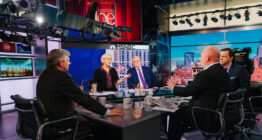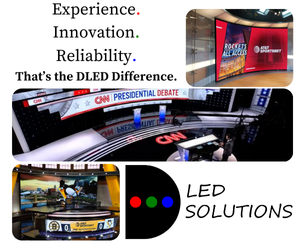How MSNBC is handling having its main studio out of commission for the summer

Subscribe to NewscastStudio for the latest news, project case studies and product announcements in broadcast technology, creative design and engineering delivered to your inbox.
With Studio 3A in Rockefeller Center undergoing major renovations after a total gut job, many major MSNBC programs have been displaced.
Prior to the pandemic and renovation, many MSNBC shows had already transitioned to using the plentiful video walls installed throughout Studio 3A and other studios inside NBC News headquarters as their primary backgrounds, so it’s relatively easily to recreate their looks using even a single video panel and camera.
While the new studio, set for a fall debut, is installed, MSNBC is making heavy use of the global media insert studios that are part of Studio 6E in Rockefeller Center as well as its other studios around the building.
6E features multiple “news nooks,” as they are sometimes referred to, that feature an anchor desk or table, chair and a large video panel for talent or guests to sit in front of. There’s typically one locked down, robotic camera to capture the action.
By utilizing the video panel as the primary background, any variety of branded or scenic imagery can be fed to it, making the spaces easy to customize for specific uses or shows.
Other networks have similar setups around the globe.
NBC has long used these setups as a way for New York based anchors, reporters, guests and analysts to appear on shows across the NBCU family, including CNBC and MSNBC, particularly when the program is originating from another NBCU facility.
Other major NBC bureaus in Washington and Los Angeles feature similar setups as well. Prior to the formal creation of the video monitor based setups, NBC, also like other networks, had a variety of smaller sets with simple, often generic physical backgrounds, that could be used for remote reports and interviews.
NBC, also like other broadcasters, ended up deploying similar setups to the homes of anchors and correspondents during the coronavirus pandemic, allowing them to fully host programming remotely.
Depending on the setup, the control room could sometimes switch what image was behind the talent; other times it had to be done manually from the remote location.
Depending on the complexity of the setup, especially with the lighting and means of transmitting the video and audio, close inspection could reveal that the shading, quality, white balance or audio feed was slightly “off” — though some highly sophisticated remote studios were created and connected via premium data lines that made it virtually impossible to distinguish if the person was at home or, say, in a news nook.
As NBC began to transition back to the studios, the insert studios came in handy as a way to socially distance guests from hosts and anchors, meaning they would sometimes be in the same building, but seated a few floors apart or, in some cases, even on the same floor but “joined together” using the familiar mutli-box layout. This practice also wasn’t uncommon prior to the pandemic if producers or a host preferred the multiple box layout or the set or production limitations didn’t accommodate in-studio guests well.
As a bonus, the spaces typically don’t require any floor crew and most of the gear in them, from lighting to audio to camera, can be controlled remotely or easily managed by the talent or a single crew member.
In many cases during remote pandemic production, the network used still or video loops of the show’s normal set or video wall background, creating the appearance that the show was still in studio. In some cases, particularly for “MSNBC Live” and later “MSNBC Reports,” photos of real studios were used, with some elements digital altered.
The network also created backgrounds that incorporated the look of various NBC studios but were largely computer generated.
Meanwhile, many of these techniques are now being replicated while Studio 3A is being rebuilt.
- “Way Too Early” typically originates from Washington, D.C. since Kasie Hunt took over anchoring, so this early morning show remains relatively unaffected unless New York based talent fills in or appears as a guest.
- “Morning Joe”: After a return to the studio after over a year of coronavirus remote production, the show shifted to Washington, D.C. for a few days once demo started in 3A. As of June 28, 2021, the show appears to have returned to remote production, which was a common occurrence even prior to the coronavirus pandemic due to a unique living situation of the married co-hosts. It’s not immediately clear if the two are in the same location.
- “Stephanie Ruhle Reports” has been originating from a single camera setup that appears to be in front of a TV monitor showing a digitally enhanced version of the “NBC Nightly News” set. Ruhle had been using a similar setup during the pandemic. It’s not clear if she is originating from a remote location or one of the network’s “news nooks” on the sixth floor of Rockefeller Center, but her audio and lighting appeared less than ideal June 28.
- “Craig Melvin Reports” has been using either Studio 4E or a single camera, locked down shot, likely in one of the insert studios. Melvin has been appearing in studio on “Today,” which originates from across the street from NBC News headquarters, so it makes sense that he would stick around to anchor his MSNBC hour later in the day.
- “Ayman Mohyeldin Reports” is, as of June 28, originating from “New York” according to what Mohyeldin said on air. It appears he is using a locked down shot with faux studio shown on the video panel behind him. His audio and lighting was notably better quality than, for example, Ruhle’s that same day, so it’s likely he’s in one of the insert studios or a tight shot in 4E.
- “Deadline: White House” has been mostly originating from Studio 4E, including having in-studio guests. Studio 4E is designed to be used “in the round,” similar to 3A, so it matches the show’s format well.
- “The Beat” has also been largely using only a single camera, though its location is not clear.
- “The ReidOut” has used the “Nightly” studio that shares the “3A” designator, but is now on a mostly single camera setup.
- “All In” has been using a single camera down shot while incorporating footage of 3A captured before the demolition to create “video on video” style shots. It had been doing this prior to Studio 3A going out of commission.
- “The Rachel Maddow Show” has been using simplified setups for some time now, both remotely and inside 30 Rock.
- “The Last Word” has also been leveraging more simplified setups.
- “The 11th Hour,” which typically ends MSNBC’s programming day (with repeats of primetime shows airing until early morning), is also using a simplified studio setup. Anchor Brian Williams has occasionally used the “Nightly” studio for this show and special coverage.
- “Kendis Gibson and Lindsey Reiser Reports” on weekends used the “Nightly” studio and anchor desk June 26 and 27, 2021, originally from the vista video wall alcove.
- “Velshi” has been using both Studio 4E and single camera setups that may be outside of NYC. Anchor Ali Velshi splits his time between New York and Philadelphia, so this could be part of the reason for the mix.
- “Alex Witt Reports” has been using 4E, including hosting in-studio guests from time to time.
While NBC and other networks have slowly begun reassembly in-studio operations, the single camera setups are not, perhaps, quite as noticeable given that many shows are still using simplified setups, being produced at least partially remotely or having guests join from home.
When a TV station or network is preparing for a new set, the transition period can be completely unnoticeable on air or may cause significant upheaval to what viewers see, depending largely on the station’s facilities and decisions.
If multiple studios exist and plans call for a studio swap, the new set can be built in the new studio while production continues as normal in the old one.
Likewise, if a single, large studio has space for multiple sets, a new set can be built, at least partially, off camera, while the old set remains completely or partially in use.
In some cases, the old set will be relocated, though often only portions are moved, and used for temporary production.
If the new set is taking over the same spot as the old set, like with many MSNBC programs that use 3A, things get trickier.
Sometimes a temporary set will be created elsewhere. This could be another studio, but broadcasters have used everything from conference rooms and newsrooms to unused corners or alcoves of the building.
These temporary sets can include some or all of the old set being physically relocated, parts of an old set or just simply be a table in front of a simple backdrop.
There are also a variety of other strategies that can be used when a studio is being renovated. For example, NBC News’ “Today” has coordinated updates to Studio 1A with the show’s broadcasts from Olympic host cities. “Morning Joe” covered at least part of its studio reno by originating from Washington during a busy week in political news.
As part of a major network, MSNBC is able to leverage the fact that it has an entire complex of studios in its building to use while one is out of commission.
Subscribe to NewscastStudio for the latest news, project case studies and product announcements in broadcast technology, creative design and engineering delivered to your inbox.





tags
MSNBC, Studio 3A, Studio 6E
categories
Broadcast Facility, Broadcast Industry News, Cable News, Featured